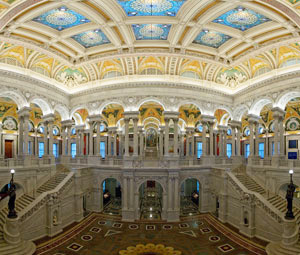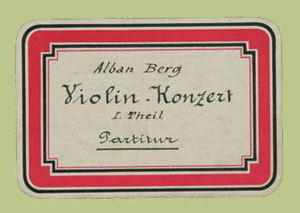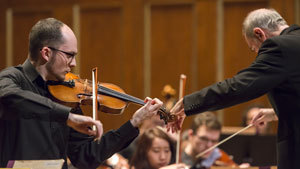The cultural riches of Washington D.C. have been a recent discovery for my family and me despite having visited the Capital on numerous occasions. My past trips have always been in a rush, either on a major orchestral tour, or on other business, and, for some reason, always centered on the Watergate part of town and that 1960s monolith in concrete, the Kennedy Center. (Why did the architects think that building in concrete was attractive??!! In her book On Architecture, Ada Louise Huxtable called it "gemütlich Speer.")
All that changed last year when my wife Virginia and I created some time for a spring break vacation and chose D.C. and a good hotel near the White House and all those museums and art galleries. The Smithsonian Institution runs 19 museums and galleries in D.C., from the Air and Space Museum to the Holocaust Museum, to the amazing Freer Gallery with its unique collection of Islamic Art as well as the works of Whistler including some of the most sublime nocturnes I have ever seen.
 But then...there is the Library of Congress, that monument to learning that is perhaps the capstone of the whole D.C. experience. Last year, we found Jefferson's Library with its collection of thousands of the books the third President bought throughout his life. They range from the French philosophers to Lucretius's poem, On the Nature of Things, that prescient work from 55 BCE that influenced Epicureanism and the American Declaration of Independence.
But then...there is the Library of Congress, that monument to learning that is perhaps the capstone of the whole D.C. experience. Last year, we found Jefferson's Library with its collection of thousands of the books the third President bought throughout his life. They range from the French philosophers to Lucretius's poem, On the Nature of Things, that prescient work from 55 BCE that influenced Epicureanism and the American Declaration of Independence.
This year, we repeated the trip but decided to include the Music Division of the Library of Congress, which I was told has around 2 million original scores. NEC's wonderful Director of Libraries, Jean Morrow, arranged a special viewing time with her opposite number and we found ourselves across the street from the Jefferson Library and greeted by two NEC alumni, Steve Yusko '72, Acting Head of Acquisitions & Processing and Susan Clermont '78 M.M., Senior Music Specialist. These two gave us the most tantalizing glimpse into the Aladdin's cave that is their collection.
 For our benefit, they had laid out various original scores across a very large desk with chairs all around, so that we could move from score to score. It was actually really difficult to move from the first one--the Brahms Violin Concerto in the composer's hand, on the manuscript he touched and wrote on. There were Brahms' corrections, influenced by the work's dedicatee, the great Hungarian violinist Joseph Joachim, along with tiny, tidy markings in red ink by his publisher. The score is obviously marked up for performance with bold conductor symbols for expression, dynamics, and rhythm. This would be the score used for the first performance with Joachim as soloist on New Year's Day in Leipzig in 1879.
For our benefit, they had laid out various original scores across a very large desk with chairs all around, so that we could move from score to score. It was actually really difficult to move from the first one--the Brahms Violin Concerto in the composer's hand, on the manuscript he touched and wrote on. There were Brahms' corrections, influenced by the work's dedicatee, the great Hungarian violinist Joseph Joachim, along with tiny, tidy markings in red ink by his publisher. The score is obviously marked up for performance with bold conductor symbols for expression, dynamics, and rhythm. This would be the score used for the first performance with Joachim as soloist on New Year's Day in Leipzig in 1879.  Displayed next to the full score was Joachim's own solo part written out by an unnamed copyist in large intelligible ink, with the occasional fingerings marked by the great virtuoso. It was fascinating comparing the score and this solo part to see what had been slightly altered. This is a work I have known all my life. A work I have heard played countless times by everyone from Menuhin to Milstein to Miriam Fried to Leonidas Kavakos. Its originality, beauty of ideas, and sheer emotional impact always leave me moved and transformed, and yet...here it was in my hands. The score. HIS SCORE. His markings. His amendments. I didn't feel like an archeologist, an Indiana Jones of the music world. It wasn't that type of discovery. It was more like seeing and touching the still beating heart of a masterpiece. My own heart beat at this point must have been racing over 200, but...there was more.
Displayed next to the full score was Joachim's own solo part written out by an unnamed copyist in large intelligible ink, with the occasional fingerings marked by the great virtuoso. It was fascinating comparing the score and this solo part to see what had been slightly altered. This is a work I have known all my life. A work I have heard played countless times by everyone from Menuhin to Milstein to Miriam Fried to Leonidas Kavakos. Its originality, beauty of ideas, and sheer emotional impact always leave me moved and transformed, and yet...here it was in my hands. The score. HIS SCORE. His markings. His amendments. I didn't feel like an archeologist, an Indiana Jones of the music world. It wasn't that type of discovery. It was more like seeing and touching the still beating heart of a masterpiece. My own heart beat at this point must have been racing over 200, but...there was more.
A score was placed in front of me. It was written in pencil and on the first page it said in German "Dem Andenken eines Engels," which after I looked at it twice realized meant "to the memory of an angel." The Berg Violin Concerto. It was there in my hands. I turned its pages and read all those astonishing ideas and saw the precision of Berg's thinking and writing.  The work, as many will remember, was commissioned by an NEC alumnus and much beloved faculty member, the late American violinist Louis Krasner. It was his courage, vision, and passionate advocacy that brought the Berg and Schoenberg concertos to the fore, with the former now established at the pinnacle of violin repertory of the 20th century. (When I returned to NEC, another one of our excellent librarians, Archivist/Records Manager Maryalice Perrin-Mohr, very kindly sent me a copy of a talk Louis gave in 1980.
The work, as many will remember, was commissioned by an NEC alumnus and much beloved faculty member, the late American violinist Louis Krasner. It was his courage, vision, and passionate advocacy that brought the Berg and Schoenberg concertos to the fore, with the former now established at the pinnacle of violin repertory of the 20th century. (When I returned to NEC, another one of our excellent librarians, Archivist/Records Manager Maryalice Perrin-Mohr, very kindly sent me a copy of a talk Louis gave in 1980.  In it, he spoke about the preparation of the Concerto, his friendship with Berg, and the first performance in Barcelona in 1936. That premiere was to have been conducted by Anton Webern, who spent most of the rehearsals on just the first few pages of the work, and in the pragmatic interest of "getting the show on the road," he was replaced by another conductor, Hermann Scherchen. I have always thought that this was an indicator of Webern's ultra sensitivity and fastidiousness, but Krasner tells a very different story. Webern was deeply affected by Berg's death barely four months before and was mourning his loss so emotionally that he couldn't go on. [Berg died in Vienna on December 24, apparently from blood poisoning caused by an insect bite. He was 50 years old.] Webern did conduct the work many times with Krasner after the premiere, most notably the U.K. performance for the BBC.)
In it, he spoke about the preparation of the Concerto, his friendship with Berg, and the first performance in Barcelona in 1936. That premiere was to have been conducted by Anton Webern, who spent most of the rehearsals on just the first few pages of the work, and in the pragmatic interest of "getting the show on the road," he was replaced by another conductor, Hermann Scherchen. I have always thought that this was an indicator of Webern's ultra sensitivity and fastidiousness, but Krasner tells a very different story. Webern was deeply affected by Berg's death barely four months before and was mourning his loss so emotionally that he couldn't go on. [Berg died in Vienna on December 24, apparently from blood poisoning caused by an insect bite. He was 50 years old.] Webern did conduct the work many times with Krasner after the premiere, most notably the U.K. performance for the BBC.)
My wonderment at seeing the Berg score was reinforced by having just heard the Concerto performed  by one of NEC's marvelous young violin students, Robert Anemone '12 '14 M.M., conductor David Loebel, and the NEC Symphony. A work that was both extremely challenging to play and to hear in the 1930s is now taken up and performed with great eloquence and fluency by young musicians today. You can hear it on InstantEncore here.
by one of NEC's marvelous young violin students, Robert Anemone '12 '14 M.M., conductor David Loebel, and the NEC Symphony. A work that was both extremely challenging to play and to hear in the 1930s is now taken up and performed with great eloquence and fluency by young musicians today. You can hear it on InstantEncore here.
While gazing at these scores, I was so absorbed that I had been ignoring my wife! In fact, I didn't even hear her when she asked very loudly: "Mozart wrote this? Mozart touched this paper?" She was holding the score of "Al desio di chi t'adora," written by Mozart as a replacement aria for Susanna's "Deh vieni, non tardar" from the Marriage of Figaro. And there it was: Mozart's determined, clear script revealing that he had everything planned out in his head before committing it to paper.
This was one of the most exciting and riveting experiences of my life. It left both of us shaking with joy and revelation. And we had barely touched the surface of this treasure trove.
It's all there for everyone. You can look at original scores online and you can go and visit and have the same experience we had. The Library of Congress is there for us all, and it's one of the most compelling reasons to keep going back to D.C.